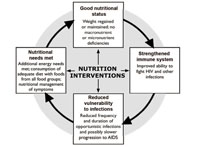12.2.2 Breaking the cycle of HIV and undernutrition
Improving and maintaining good nutrition may prolong health and delay the progression of HIV to AIDS. Because the impact of proper nutrition begins early in the course of HIV infection, even before other symptoms are observed, as a Health Extension Practitioner you will have an opportunity to make a real impact on the lives of people living with HIV (PLHIV).
Nutrition care and support helps PLHIV maintain and improve their nutritional status, improve their immune response, manage the frequency and severity of symptoms, and improve their response to antiretroviral therapy (ART) and other medical treatment. Figure 12.2 illustrates how the cycle between HIV and malnutrition can be broken using different interventions.

Have a close look at Figure 12.2. Can you tell from this figure how the vicious cycle between HIV and poor nutrition can be reversed?
Figure 12.2 illustrates how effective nutrition interventions such as an increased and varied diet with food from different food groups, can help transform the cycle of HIV and undernutrition into a positive relationship between improved nutritional status and stronger immune response, which will reduce vulnerability to infections.
12.2.1 Poor nutrition and HIV: a vicious cycle
